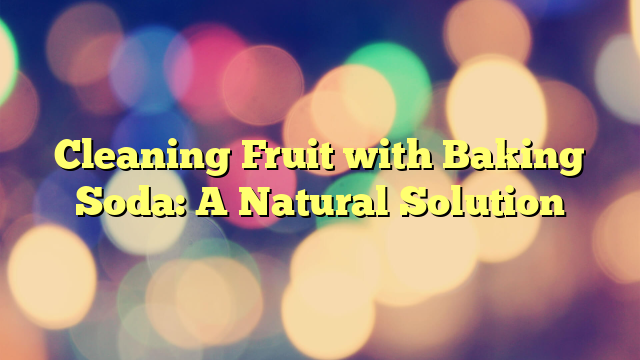In the quest for healthier living, many of us are becoming increasingly mindful of the foods we consume. From selecting organic produce to scrutinizing food labels, we strive to make choices that promote well-being. Yet, one aspect often overlooked is the cleanliness of the fruits and vegetables we bring home. Pesticides, dirt, and bacteria can linger on their surfaces, potentially posing health risks if consumed. Fortunately, there’s a simple and natural solution: cleaning fruit with baking soda.
Understanding the Need for Fruit Cleaning with Baking Soda
Before explore the wonders of baking soda, it’s crucial to comprehend why cleaning fruit is necessary. Despite our best efforts, fruits can harbor various contaminants, including pesticide residues, dirt, and microorganisms. These substances may not be visible to the naked eye, but their presence can have adverse effects on health if ingested.
Pesticide residues, for instance, have been linked to a range of health issues, including hormone disruption, developmental delays in children, and certain types of cancer. Similarly, bacteria and dirt can lead to foodborne illnesses, causing symptoms such as nausea, vomiting, and diarrhea. Given these risks, ensuring that our fruits are thoroughly cleaned before consumption is paramount.
What is Baking Soda: Nature’s Cleaning Agent
Amidst a plethora of commercial fruit cleaners and washes, baking soda emerges as a cost-effective and natural alternative. Sodium bicarbonate, commonly known as baking soda, possesses inherent properties that make it an effective cleaning agent. Its mildly abrasive nature helps dislodge dirt and debris from the fruit’s surface, while its alkalinity can neutralize pesticide residues and inhibit bacterial growth.
How to Clean Fruit with Baking Soda
Cleaning fruit with baking soda is a straightforward process that requires minimal effort. Here’s a step-by-step guide to help you harness the power of this natural cleaning agent:
1. Prepare a Baking Soda Solution
Begin by mixing one teaspoon of baking soda with two cups of water in a clean container. Stir the solution until the baking soda is fully dissolved.
2. Soak the Fruit
Submerge the fruits in the baking soda solution, ensuring that they are completely covered. Allow them to soak for 10-15 minutes. During this time, the baking soda will work its magic, loosening dirt and neutralizing pesticides.
3. Gently Scrub (if necessary)
For fruits with thicker skins or stubborn dirt residues, gently scrub the surface with a soft brush or sponge. Be careful not to apply too much pressure, as this may damage delicate fruits.
4. Rinse Thoroughly
After soaking, remove the fruits from the baking soda solution and rinse them under cold running water. Ensure that all traces of baking soda are washed away, leaving behind clean and fresh produce.
5. Dry and Enjoy
Pat the fruits dry with a clean kitchen towel or allow them to air dry before consumption. Now, your fruits are ready to be enjoyed, free from harmful contaminants.
Is It Safe to Wash Fruits With Baking Soda
Yes, it is safe to wash fruits with baking soda. Baking soda, also known as sodium bicarbonate, is a mild and natural cleaning agent that is commonly used in household cleaning and cooking. When used to wash fruits, baking soda can effectively remove dirt, wax, pesticides, and other residues from the surface of the fruit.
Benefits of Cleaning Fruit Wit Baking Soda
- Natural and Safe: Unlike commercial fruit cleaners that may contain harsh chemicals, baking soda is a natural and safe alternative. It poses no risk of chemical residue on your fruits and is gentle enough for regular use.
- Effective Against Pesticides: Baking soda’s alkaline nature helps to break down and neutralize pesticide residues, reducing your exposure to harmful chemicals.
- Versatile: Baking soda is not only effective for cleaning fruits but can also be used to clean vegetables, remove stains, and freshen up kitchen surfaces.
- Cost-Effective: Baking soda is readily available in most households and is incredibly affordable compared to commercial fruit washes.
How to Clean Fruit with Vinegar
Cleaning fruit with vinegar is a natural and effective way to remove dirt, bacteria, and pesticide residues from their surface. Vinegar, particularly white vinegar or apple cider vinegar, contains acetic acid, which has antimicrobial properties that help kill bacteria and other pathogens. Cleaning fruit with vinegar is a simple and environmentally friendly process. Here’s a step-by-step guide:
Step 1: Prepare the Vinegar Solution
- Fill a clean sink or a large bowl with cold water.
- Add vinegar to the water at a ratio of 1 part vinegar to 3 parts water. You can use either white vinegar or apple cider vinegar.
Step 2: Soak the Fruit
- Place the fruit in the vinegar solution, ensuring it’s fully submerged.
- Allow the fruit to soak for about 5-10 minutes. This soaking period helps loosen any dirt, wax, or pesticide residues clinging to the fruit’s surface.
Step 3: Swirl or Gently Agitate
- Occasionally swirl or gently agitate the fruit in the solution to ensure thorough cleaning.
Step 4: Rinse Thoroughly
- After soaking, remove the fruit from the vinegar solution.
- Rinse the fruit thoroughly under running water to wash away any remaining vinegar residue, dirt, or residues.
Step 5: Pat Dry
- Once rinsed, pat the fruit dry with a clean kitchen towel or paper towel.
- Alternatively, you can allow the fruit to air dry before consuming or storing it.
Benefits of Cleaning Fruits With Vinegar
- Natural and Non-Toxic: Vinegar is a natural ingredient that is safe to use on fruit. It doesn’t leave behind any harmful residues, making it safe for consumption.
- Antimicrobial Properties: The acetic acid in vinegar helps kill bacteria and other pathogens, reducing the risk of foodborne illnesses.
- Removes Pesticide Residues: Vinegar effectively removes pesticide residues from the surface of fruit, promoting safer consumption.
- Easy to Use: Cleaning fruit with vinegar requires minimal effort and can be easily incorporated into your regular food preparation routine.
- Versatile: Vinegar can also be used for various other household cleaning tasks, making it a versatile and cost-effective cleaning solution.
How to Clean Vegetables with Baking Soda
1. Prepare the Baking Soda Solution for Vegetables
Fill a clean sink or a large bowl with cold water. Add about one tablespoon of baking soda per gallon of water. Stir the solution to ensure the baking soda dissolves completely.
2. Soak the Vegetables
Place the vegetables in the baking soda solution, ensuring they are fully submerged. Allow them to soak for 10-15 minutes. This soaking period helps loosen dirt, pesticide residues, and other contaminants.
3. Scrub the Vegetables (if necessary)
For vegetables with thicker skins or surfaces, such as potatoes or carrots, you can use a vegetable brush or cloth to gently scrub the surface while they are soaking. This step can help remove stubborn dirt and residues more effectively.
4. Rinse Vegetables Thoroughly
After soaking, remove the vegetables from the baking soda solution and rinse them thoroughly under cold running water. Ensure all traces of baking soda, dirt, and residues are washed away.
5. Dry the Vegetables
Pat the vegetables dry with a clean kitchen towel or paper towel. Alternatively, you can allow them to air dry before storing or cooking.
Pro Tips: How to Clean Mattress with vinegar and baking soda
How to Clean Fruits With Apple Cider Vine
Cleaning fruits with apple cider vinegar (ACV) is a natural and effective way to remove dirt, bacteria, and pesticide residues from their surface. Apple cider vinegar contains acetic acid, which has antimicrobial properties that help kill bacteria and other pathogens. Here’s how you can clean fruits using apple cider vinegar:
1. Prepare the Solution
In a large bowl or clean sink, mix equal parts water and apple cider vinegar. You can also dilute the vinegar further if you prefer a milder solution.
2. Soak the Fruits
Place the fruits in the apple cider vinegar solution, ensuring they are fully submerged. Allow them to soak for 5-10 minutes. This soaking period helps to loosen dirt, bacteria, and pesticide residues.
3. Swirl or Gently Agitate
Occasionally swirl or gently agitate the fruits in the solution to ensure thorough cleaning.
4. Rinse Thoroughly
After soaking, remove the fruits from the vinegar solution and rinse them thoroughly under running water. Ensure all traces of vinegar, dirt, and residues are washed away.
5. Dry the Fruits
Pat the fruits dry with a clean kitchen towel or paper towel. Alternatively, you can allow them to air dry before consuming or storing.
Benefits of Cleaning Fruits with Apple Cider Vinegar (ACV)
- Natural and Non-Toxic: Apple cider vinegar is a natural ingredient that is safe to use on fruits. It does not leave behind any harmful chemical residues, making it suitable for those looking for eco-friendly cleaning options.
- Antimicrobial Properties: The acetic acid in apple cider vinegar helps kill bacteria and other pathogens, reducing the risk of foodborne illnesses.
- Removes Pesticide Residues: Apple cider vinegar effectively removes pesticide residues from the surface of fruits, promoting safer consumption.
- Easy to Use: Cleaning fruits with apple cider vinegar requires minimal effort and can be easily incorporated into your regular food preparation routine.
- Versatile: Apple cider vinegar can also be used for various other household cleaning tasks, making it a versatile and cost-effective cleaning solution.
Cleaning Dragon Fruit with Baking Soda
Cleaning dragon fruit with baking soda is a straightforward and effective method to ensure it’s free from dirt, wax, and any pesticide residues. Dragon fruit, also known as pitaya, has a unique appearance with its vibrant pink or yellow skin and speckled flesh filled with edible seeds. Here’s a simple guide on how to clean dragon fruit using baking soda:
Step 1: Prepare the Baking Soda Solution
- Fill a clean sink or a large bowl with cold water.
- Add about one tablespoon of baking soda per gallon of water.
- Stir the solution to ensure the baking soda dissolves completely.
Step 2: Soak the Dragon Fruit
- Place the dragon fruit in the baking soda solution, ensuring it’s fully submerged.
- Allow the dragon fruit to soak for about 10-15 minutes. This soaking period helps loosen any dirt, wax, or pesticide residues clinging to the skin.
Step 3: Gently Scrub (if necessary)
- If the dragon fruit has thick or rough skin, such as those with scales, you can use a soft brush or cloth to gently scrub the surface while it’s soaking. This helps remove any stubborn dirt or residues more effectively.
Step 4: Rinse Thoroughly
- After soaking, remove the dragon fruit from the baking soda solution.
- Rinse the dragon fruit thoroughly under running water to wash away any remaining baking soda residue, dirt, or residues.
Step 5: Pat Dry
- Once rinsed, pat the dragon fruit dry with a clean kitchen towel or paper towel.
- Alternatively, you can allow the dragon fruit to air dry before consuming or storing it.
How Hydrogen Peroxide Wash Vegeta
Step 1: Prepare the Hydrogen Peroxide Solution
- Dilute hydrogen peroxide with water. A common ratio is one part hydrogen peroxide to ten parts water. You can adjust the concentration depending on the sensitivity of the vegetables.
- Alternatively, you can use food-grade hydrogen peroxide without dilution, but be cautious as it is more concentrated.
Step 2: Soak the Vegetables
- Place the vegetables in a clean sink or bowl.
- Pour the diluted hydrogen peroxide solution over the vegetables, ensuring they are fully submerged.
Step 3: Soak Time
- Allow the vegetables to soak in the hydrogen peroxide solution for about 5-10 minutes. This soaking period helps to loosen any dirt, bacteria, or pesticide residues.
Step 4: Gently Scrub (Optional)
- If the vegetables have thick or rough surfaces, such as potatoes or carrots, you can use a vegetable brush to gently scrub them while they are soaking. This step can help remove stubborn dirt or residues more effectively.
Step 5: Rinse Thoroughly
- After soaking, remove the vegetables from the hydrogen peroxide solution.
- Rinse the vegetables thoroughly under running water to wash away any remaining hydrogen peroxide, dirt, or residues.
Step 6: Pat Dry
- Once rinsed, pat the vegetables dry with a clean kitchen towel or paper towel.
- Alternatively, you can allow the vegetables to air dry before consuming or storing them.
How do you clean strawberries with Vinegar
Washing strawberries in vinegar is a simple and effective method to remove dirt, bacteria, and pesticide residues from their surface. Vinegar, particularly white vinegar or apple cider vinegar, contains acetic acid, which has antimicrobial properties that help kill bacteria and other pathogens. Here’s a step-by-step guide on how to wash strawberries using vinegar:
Step 1: Prepare the Vinegar Solution
- Fill a clean sink or a large bowl with cold water.
- Add vinegar to the water at a ratio of 1 part vinegar to 3 parts water. You can use either white vinegar or apple cider vinegar.
Step 2: Soak the Strawberries
- Place the strawberries in the vinegar solution, ensuring they are fully submerged.
- Allow the strawberries to soak for about 5-10 minutes. This soaking period helps loosen any dirt, bacteria, or pesticide residues clinging to the strawberries’ surface.
Step 3: Gently Swirl or Agitate
- Occasionally swirl or gently agitate the strawberries in the solution to ensure thorough cleaning.
Step 4: Rinse Thoroughly
- After soaking, remove the strawberries from the vinegar solution.
- Rinse the strawberries thoroughly under running water to wash away any remaining vinegar residue, dirt, or residues.
Step 5: Pat Dry
- Once rinsed, pat the strawberries dry with a clean kitchen towel or paper towel.
- Alternatively, you can allow the strawberries to air dry before consuming or storing them.
Sources:
- https://www.assuaged.com/news/how-to-wash-fruits-and-vegetables-with-vinegar-and-baking-soda
- https://www.tru.earth/cleaning-fruits-with-baking-soda-and-vinegar
- https://armandhammerarabia.com/get-cleaner-fruits-and-vegetables-with-baking-soda/
Happy Cleaning





